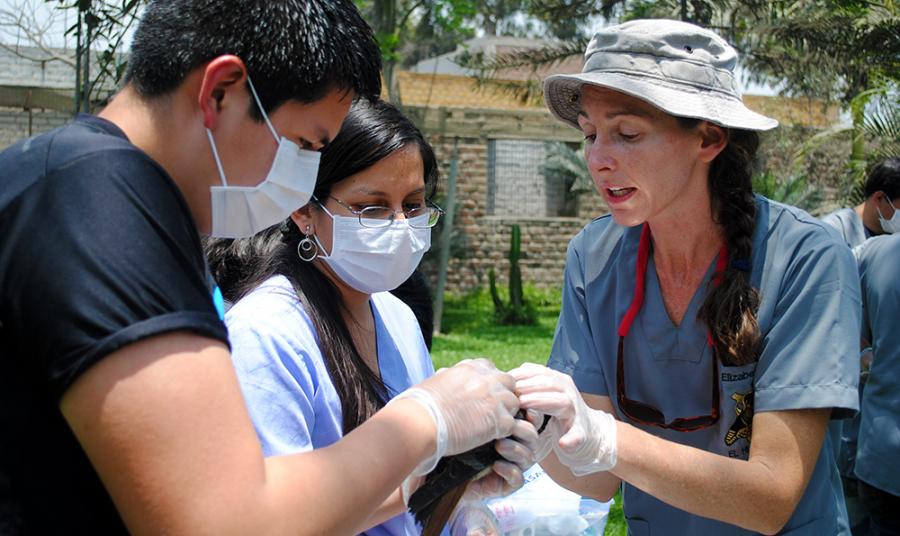
The National Socio-Environmental Synthesis Center (SESYNC) is pleased to welcome to our Annapolis center Dr. Elizabeth Daut, a Socio-Environmental Immersion Postdoctoral Fellow. Get to know our newest researcher:
Name: Elizabeth Daut
PhD: Veterinary Pathobiology, Texas A&M University
Hometown: White Plains, New York
SESYNC Project: Mitigating conservation threats associated with global wild and exotic animal pet trade, infectious diseases, and regulatory importation gaps in the United States
Mentor/Collaborator: Dr. Karen Lips, University of Maryland
How would you describe your primary field of study?
That’s complicated, because I have a mixed background. If I have to be succinct, then I would say I’m a conservation medic—but most people don’t understand what that means. So if I can be a little longer winded, then I would say I’m a wildlife veterinarian currently doing research in applied biodiversity science that links animal, human, and environmental health.
Can you briefly describe your proposed SESYNC postdoctoral project?
At SESYNC, I’ll be looking at disease risk associated with the global pet trade. The U.S. exotic pet industry is a billion dollar entity, but the U.S. currently has no specific import regulations to mitigate disease threats facing native wildlife from legally imported or smuggled wild and exotic animals. These imported animals may harbor harmful pathogens, and if they are accidentally or deliberately released into our landscape, they may pass those pathogens to our native wildlife, which in turn has implications for both ecosystem and human health.
A better understanding of the intersection of supply and demand of wild and exotic animal pets, risk of introduced disease, and current gaps in U.S. import regulations will help us develop targeted, cost-effective responses. My project will help provide the necessary scientific, evidence-based recommendations to develop policies and interventions that prioritize the disease threat, regulate the problem, and assure social and economic trade benefits.
Can you point to a recent example of disease spread through the exotic pet industry?
Yes, I can! There is a specific example getting a lot of media attention right now. It has to do with a fungal infection that is spreading among native salamander populations in Europe. This new pathogen, called Batrachochytrium salamandrivorans or Bsal, was first identified in Belgium, and they believe it entered the country via the exotic pet trade, particularly from import of fire-bellied newts from Asia. This newt is a carrier of Bsal, meaning it doesn’t actually develop symptoms of the disease. But it can transmit the pathogen to immunologically naïve populations of native salamanders, causing high mortality rates very quickly.
The risk is that this fungus could make its way into the U.S. That’s a huge concern because the U.S. has the highest diversity of salamander species in the entire world, including many endemic species that are found only here. According to laboratory studies, many of these species are susceptible to this fungus—so if it does get here and into our native salamander populations, they could easily be decimated. So scientists are calling on the U.S. Fish and Wildlife Service to ban the import of salamanders to prevent the spread of Bsal into the U.S., at least until better diagnostics and treatment options develop, because eliminating the fungus once it’s here is virtually impossible.
What inspired you to choose this field of study?
My passion for wildlife trade issues resulted from my experience as a Peace Corps volunteer in Ecuador, where there was a lot of illegal trade of wild-caught animals. I co-founded the first animal welfare organization in southern Ecuador to try to combat the illegal wildlife trade, and worked with the environmental ministry as a wildlife inspector. I quickly realized that the problem was bigger than just improving law enforcement; it’s really about the consumer. The wildlife trade is not unlike the drug trade—it will persist as long as there’s demand.
What’s the best professional advice you’ve ever received?
The KISS principle: Keep It Simple, Stupid. I have a tendency to go too deep or make the story too complicated, but if you want your research to have an impact you need to communicate your ideas succinctly.
What are you reading right now?
I just finished “Averting a North American biodiversity crisis” by Tiffany Yap et al. in Science.
What’s your favorite scientific theory?
I really like the theory of island biogeography. I’m not an ecologist, but the concept that you can anticipate how species expansion will progress based upon the geographic metrics of distance and area—it’s pretty cool.
What’s your favorite science word?
Pseudohypoparathyroidism. I just like saying it.
What’s your least favorite science word?
How about ‘bias’? It’s tricky because the term itself can be interpreted in so many different ways, and it can influence your data in so many different ways.
The National Socio-Environmental Synthesis Center, funded through an award to the University of Maryland from the National Science Foundation, is a research center dedicated to accelerating scientific discovery at the interface of human and ecological systems. Visit us online at www.sesync.org and follow us on Twitter @SESYNC.